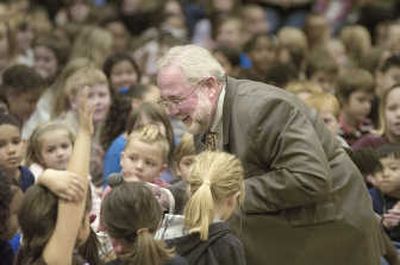Grant students witness stamp’s unveiling

The students at Grant Elementary School recently witnessed the unveiling of a new stamp and learned about diversity in schools.
The stamp commemorates the 60th anniversary of a 9th Circuit Court of Appeals ruling that set precedent for Brown v. Board of Education.
In 1944, Gonzalo and Felicitas Mendez wanted their children to attend the Main Street School in Westminster, Calif. Gonzalo had attended the school when he was a child, but since then, the district boundaries had been redrawn, and children of Mexican descent were required to attend “Mexican schools.”
These schools were inferior to other schools in the district – the facilities were shabby and there were inadequate supplies. The children were required to speak English at all times and often were struck with rulers for speaking Spanish or mispronouncing words in English.
The Mendez family and several other families decided to sue the school district and others nearby on behalf of 5,000 children.
The lawyer for the family, David Marcus, consulted social scientists to argue that the schools were not beneficial to the students.
Federal District Judge Paul McCormick ruled in favor of the Mendez family in 1947, saying that “social equality is ‘a paramount requisite’ in America’s public school system,” according to educational information provided by the post office to the students of Grant.
“A lot of change came from this case,” said Ricardo Rico, the state director of the League of United Latin American Citizens (LULAC). The organization took on the case on behalf of the Mendez family.
It was seven years, 1954, after the ruling when the U.S. Supreme Court handed down the verdict of Brown vs. the Board of Education.
Last Friday, in a standing-room-only gymnasium, the students of Grant Elementary School witnessed the unveiling of the stamp.
Yvonne Lopez-Morton, a member of the state Commission on Hispanic Affairs, introduced the guests at the school and read a greeting from Gov. Chris Gregoire to the students.
“Diversity is one of our nation’s greatest strengths,” Gregoire said in her letter.
Lopez-Morton also asked the students if they knew how to say “good afternoon” in Spanish—buonas tardes.
Spokane Mayor Dennis Hession explained the case to the students in a way they could understand.
“What would happen if you didn’t get to go to Grant Elementary anymore?” he asked them. “Do you think that would be fair?”
The students didn’t think so.
Spokane Postmaster Ed Schierberl told the students that the pictures chosen for stamps are ones that are that are about America, are interesting or are educational.
Julie Perron, the principal at Grant, said that the students spent time studying the case. There were lessons about it in the school’s resource room, and the third-grade class spent time writing about the case in journals.
She felt that the kids really took to the lessons since the Mendez v. Westminster dealt with which schools the children could attend. It was something they could relate to and felt empathy for the Mendez family.
Perron was also impressed with the stamp itself, which was designed by artist Raphael Lopez.
“It demonstrates the vibrancy of Latino art and culture,” she said.
Although the stamp was unveiled at Grant last week, it has been in circulation since Sept. 14 and was originally unveiled in Santa Ana, Calif., one of the cities with a school district that was included in the lawsuit.
Lisa Nystuen, of customer relations at the U.S. Postal Service in Spokane, said that it was common to do a secondary unveiling of stamps when it is decided that a stamp design is significant locally.
For example, a stamp series featuring wooden boats received a secondary dedication in Coeur d’Alene. A baseball stamp received a secondary dedication at a Spokane Indians game.
“It depends on the area and what we want to do,” she said.
There can be only one original dedication when a stamp is unveiled. After that day, any city can dedicate the stamp.
There hasn’t been an original dedication in Spokane since the 33-cent Lilac stamp was unveiled.
Nystuen said that the secondary dedication was done at Grant, since the post office found that the school was one of the most diverse in the area.
But the fact that the unveiling was a secondary one didn’t hurt the enthusiasm of the students and other Latinos in the community.
“A lot of people will be buying them,” Rico of LULAC said. “(The case) is an excellent showing of what our due process is all about.”
Grant Elementary didn’t seem to mind either. When the stamp was unveiled by Hession and Perron, there was a lot of enthusiastic clapping and cheering.
“I’m going to remember this moment forever,” Perron said to the children. She said the stamp gave her hope for the future.